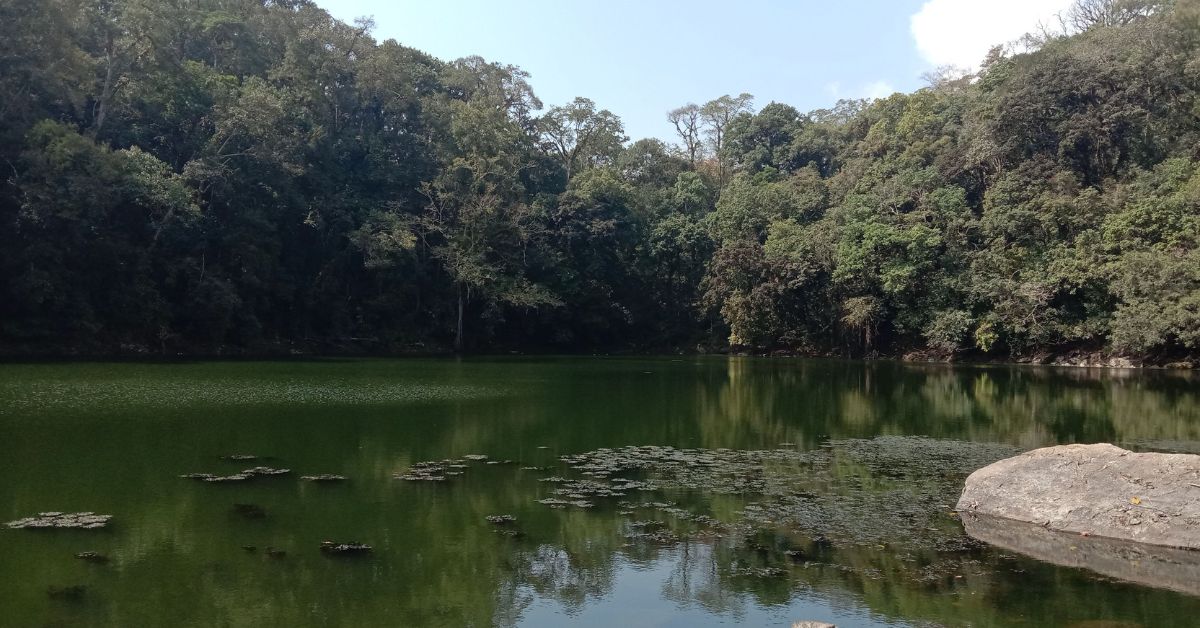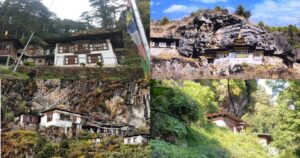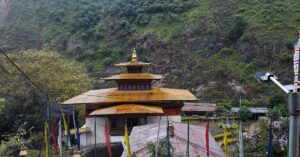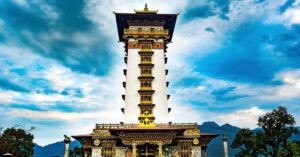Buli Tsho is a sacred lake considered to be the Palace of Kheng Buli’s protector goddess, Tshomen Kuntu Zangmo, also known as Buli Moenmo, the mermaid guardian deity nestled in Buli village under Zhemgang Dzongkhag. The Buli Tsho has a surface area of 2 hectares and an elevation of 1372 meters. The portrait of Tshomen Kuntu Zangmo can be seen on the wall of the famous Buli Lhakang.
The residents of Kheng Buli worship the Moenmo by reciting prayers and offering khadhar. They often perform Moenmo rituals to accumulate merit, cure sickness, and ward off bad luck.
A pilgrimage to Kheng Buli Tsho is one of Bhutan’s best hikes/treks. Buli Tsho doesn’t entertain camping and glamping, unlike Domendrel Tsho and Drakey Pangtsho, which are best for one-night camping or glamping excursions.
The Tsho was also blessed by many religious saints, including Ponlop Khen Rinpoche, His Holiness Tulku Jigme Choedra, His Eminence Namkhai Nyingpo Rinpoche, His Eminence Gangteng Tulku Rinpoche, Peling Sungtrul Rinpoche, Kyabji Thuksey Rinpoche, Kathok Situ Rinpoche, and Buli Tulku, among others.
Also Read: Mebar Tsho, the Burning Lake, where Pema Lingpa discovered Hidden Treasures.
Things You Should Know Before Visiting BuliTsho
The Buli community has designated two months of the year as restricted months for visiting the lake (2 months Kagdam from the 1st day of the 8th Bhutanese month). These two months are the harvest season of the Kheng region.
People who have touched a dead body, people whose spouse has died recently, and ladies during menstruation time are asked not to visit the lake as the community believes that they will become sick, and natural disasters will destroy their crops.
When visiting the Tsho, visitors must dress in traditional attire. An alcoholic libation and milk offering, hoisting prayer flags (Lungdhar), and bringing meat products are all forbidden at the lake.
To maintain the serenity of the Buli Tsho and provide a perfect ambiance, visitors are prohibited from camping and defiling the surroundings. Smoking and drinking are strictly prohibited. Picnicking around the lake is also prohibited.
How to Reach Kheng Buli Tsho
The mermaid lake in Bhutan, less than 5 kilometers south of Nangkhor Gewog center, is surrounded by a peaceful atmosphere. Amid the serenity, an unsettling atmosphere pervades.
Zhemgang Dzongkhag is 56 kilometres away from the Nangkhor gewog. It takes about 15 minutes by car and 30 minutes on foot from the Nangkhor Gewog center with a shortcut.
Also Read: Dangling Tsho, the Sacred Summer Abode of Meme Dangling
Sacred Relics to See at Bulitsho
The lake’s beauty is the appearance of two water birds on occasion. The two ducks are thought to be the lake’s cleaners. The ducks are believed to clean the lake daily by removing all the leaves that fall into the lake. They also clear all the white bubble-like stuff grown over the lake.
Spectacular and unusual sightings that science cannot explain have been recorded at the lake site several times. If the visitors are lucky and blessed with merit, Moenmo is said to display her Phodrang, rampart, conch, prayer flag, butter lamp, and flower. If they are lucky, people also believe they will be blessed with gifts such as a conch, pearls, and an urn.
The house where the mermaid stayed is still standing today. The fifth generation of Lui Phodrang’s residents (the palace of the mermaid) still lives there.
The lake is known for its clarity and is considered an unlucky sign if the color darkens and becomes dull.
Also Read: Jo Bay Tsho, a Hidden Lake with a Golden Pillar in Haa
Historical Significance of Buli Tsho
There are several versions of the Buli Tsho story, none of which has been officially published. Here’s the Buli Tsho story:
A Sister’s Promise to Reunite with Her Brother
This is the story of a sister who made a promise to her brother and the journey she took to keep the promise.
The legend dates back to the late 17th century. A brother had agreed to follow a prophecy and travel south to Bhutan after winning several battles in Tibet. His sister (a mermaid), who had been by his side during his wars, could not accompany him on this voyage for some reason. However, she promised her brother that the two siblings would reunite in Bhutan.
As per her promise, the sister came to Bhutan in search of her brother. She first arrived in Dungkar, Lhuentse, then traveled to Chumey, Bumthang, and finally to Buli, Zhemgang. In Buli, the sister disguised herself as a woman and found refuge in a house in Trongmeth. She was greeted by an elderly lady who permitted her to remain in the altar room.
The mermaid only showed a portion of her face and asked the old lady not to bother her. The old lady wanted to show hospitality by offering Ara (local wine). She went ahead and peered through a hole in the altar room. The old lady was shocked to see a large snake sleeping.
The mermaid claimed some areas beneath the main settlement and built her Phodrang (palace) in the form of a lake after leaving the house in Trongmeth. The nearby village, however, polluted the water, so the mermaid relocated her Phodrang to the south, near the current lake. Since the new site was at a tri-junction, continuous human movement once again polluted the lake. She eventually relocated to her present location.
The Legend of Buli Ponpo
According to another legend, the first Buli Ponpo was the nephew of the lake’s deity, Buli Moenmo. The lake was miraculously built on the spot where a stranger who had asked villagers for hospitality had slept the night before. Following the lake formation, a farmer’s daughter began acting strangely. She was missing from home one morning, and while searching, her worried father came across the lake, where he discovered several perfectly made pots (Thro), except for one that had a defect, and realized that the others had vanished. He held the pot and became extremely wealthy, and his descendants became Buli Ponpos after that.
Terton Pema Lingpa and Terton Dorji Lingpa have visited the lake and bestowed blessings on the Menmo.
Also Read: The Historical Significance of Domendrel Tsho, where Gyalse Tenzin Rabgye offered Mandala Offerings.
Best Time to Visit Kheng Buli Tsho
Buli Tsho Lake remains one of the main attractions for all pilgrims and tourists to the Dzongkhag, thanks to improved road access. The best time of the year to visit Buli Tsho is from December to August. The lake is closed to the public from the 1st day of the 8th month to the 15th day of the 10th month of the Bhutanese calendar, roughly corresponding to September to November.
The Kheng Buli community has now appointed a caretaker, who is in charge of raising entry fees of Nu. 30 from locals and Nu 100 from tourists. The money raised from pilgrims and other tourists is used twice a year to make offerings to Tshomen. You can contact the caretaker there.
Also Read: The Best Time to Hike to Kabji-Hoka Tsho, a Lake with an Opening to Stop Overflowing
Conclusion
The journey to Buli Tsho, the Promised Lake of Buli Moenmo Kuntu Zangmo, is a captivating blend of natural beauty and rich spiritual heritage. Nestled in the serene forests of Zhemgang, this lake serves as a significant pilgrimage site, deeply revered by the local community for its connection to the guardian goddess, Tshomen Kuntu Zangmo. The legends surrounding the lake, including the poignant tale of a sister’s promise to her brother, enhance its mystical allure and invite visitors to reflect on themes of devotion and connection. You can visit the sacred lakes in Bhutan with the Bhutan Pilgrimage Package.
Places to Explore in Zhemgang
Zhemgang Dzong: It is a fortress at the site of a hermitage founded by Lama Zhang Dorje Drakpa in 1163. It was built by Zhabdrung Ngawang Namgyal as a symbol of the unification of Khengrig Namsum in 1655.
Duenmang Tshachu: Also known as Kheng Tshachu, it is a renowned hot spring believed to heal various ailments, including indigestion, joint pain, sinusitis, and skin diseases.
Trong Heritage Village: This village features traditional stone masonry houses on a hillock overlooking Zhemgang Dzong. It showcases Bhutanese architecture with earthquake-resistant techniques and cobbled pathways.
Wamling Gaden Tashicholing: It is a Buddhist monastery or institution, likely inspired by the Gaden tradition of Tibetan Buddhism, which emphasizes the teachings of Lama Je Tsong Khapa.
Enjoyed reading this blog?




